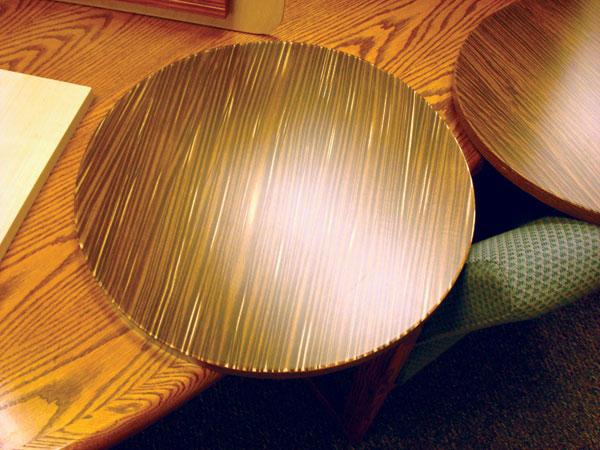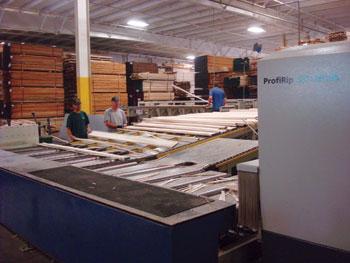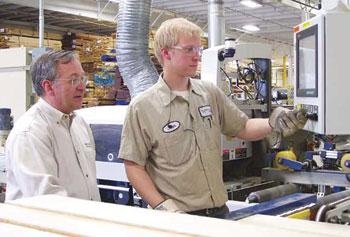Novel Moulder Adds Texture to Wood




The Great Recession has put a big hurt on the vast majority of North American woodworking operations.
Industry news headlines have been a steady stream of layoffs, plant closings and even bankruptcies. The dearth of business, especially for those companies that count on a strong housing market, has also forced many woodworking businesses to postpone investments in new woodworking equipment.
Great Lake Woods Inc., a manufacturer of hardwood and laminated mouldings and components based in Holland, MI, has hardly been immune to the stresses and strains of the economic downturn. It has had to make operational adjustments to weather the storm. Fortunately the company has been able to deflect the full brunt of the recession because of its diversification in a variety of markets, including architectural and residential mouldings, and parts for furniture, cabinets, store fixtures, picture frames and more.
In addition, while firmly founded on hardwood products, Great Lake Woods also makes products using MDF, plastic, non-ferous metals and other materials.
| Great Lake Woods operates a fully automated rough mill that takes boards from grading to ripping and cross cutting. |
Keith Malmstadt, president of Great Lake Woods, would certainly prefer that business was humming along as it had pre-recession. The silver lining, he says, is that the downturn has created opportunities for research and development of new products.
“You have to develop products when business is slow,” Malmstadt says. “It’s much more difficult to develop new products when you are running at capacity. There just isn’t enough time when you are taking and processing orders non-stop.”
A prime example of taking advantage of downtime to build for the future was Malmstadt’s visit to the Ligna Hannover fair in Germany in May 2009. It was the first time in his more than 15-year career with Great Lake Woods that he had the mind and the time to attend the world’s largest woodworking technology fair.
Accompanied by Jim Scarlett, president of Scarlett Machinery, a Grand Rapids, MI-based woodworking machinery distributor, Malmstedt took advantage of his Germany trip to attend an open house technology expo held at Michael Weinig’s world headquarters in Tauberbischofscheim. There, amid dozens of machinery demonstrations and displays, he spied samples of distressed wood mouldings that would normally be done by hand. Intrigued, he learned the grooved parts had been created on a Weinig moulder outfitted with a specialized head. The one-of-a-kind machine was installed at a plant in former East Germany.
While Malmstadt was not able to rearrange his trip to visit the factory and see the specialty moulder in action, he was interested enough to make a second sojourn last fall to do so. He realized that there is a strong market for hand-scraped wood for flooring and other product applications. He also realized that automating the process could allow him to pump out product faster and at a lower cost.
| Three samples of the design effects of combining the texturizing moulder with finishes. |
JIT for KBIS
Great Lake Woods’ negotiations with Weinig to produce the first textured moulder for the Western Hemisphere culminated with the installation of a specially-outfitted Powermat 500 moulder in April. With installation and the addition of a second Roundamat knife grinder, the total investment was about $600,000. He adds that his deal with Weinig provides him North American exclusivity of the technology until October.
“We had the machine installed and operating just in time to produce sample parts for our exhibit display at the Kitchen and Bath (Industry) Show in Chicago,” Malmstadt says.
The samples caught the eye of many kitchen designers and manufacturers who visited the company’s booth. Malmstadt says it was fun to watch them run their hands up and down the textured parts and to answer their questions about how they were made.
About the Machine
The newest of eight Weinig moulders now running at Great Lake Woods 103,000-square-foot main plant incorporates all of the features of other Powermat 500 moulders, including PowerLock tool holders to speed set-up adjustments. The two key differences are the additional texturizing head and the 12-inch board capacity, allowing parts more than 33% wider to be processed than the standard 8-7/8-inch capacity.
The 12-inch capacity is allowing Great Lake Woods to produce plank flooring and other wider products. For the purpose of textured wood mouldings, the machine is limited to 10-inch-wide mouldings because the texturizing heads require 1 inch of clearance on each side of the part.
In addition, while the machine can operate at 40 to 50 feet per minute to process standard mouldings, feed speeds are reduced to about 20 feet per minute for running textured mouldings. Immediately after the part is profiled it passes under the seventh head that randomly produces a series of approximately ¼-inch grooves in the moulding.
Great Lake Woods makes its own tooling on its two Weinig Roundamat grinders. The texturizing knives are ground from high-speed steel. In addition to making the tools, the toolroom employees constantly monitor tool wear via software that networks tool room computers to the knives mounted on the machine.
Next Stop: IWF
Great Lake Woods is still experimenting with textured wood, finding that the process offers virtually unlimited design possibilities. In addition to flooring, applications include doors, drawer faces, valances, table tops, beam fascias, furniture components, ceilings, trim and more.
“We’re prepared to offer quantities of 100 feet or more,” Malmstadt says.” Ideally orders will be at least 2,000 to 3,000 linear feet.”
Malmstadt says he looks forward to showing off textured wood mouldings to attendees of the International Woodworking Supply Fair, Aug. 25-28 in Atlanta. By then, he adds Great Lake Woods will have a couple of other products ready to debut.






Have something to say? Share your thoughts with us in the comments below.